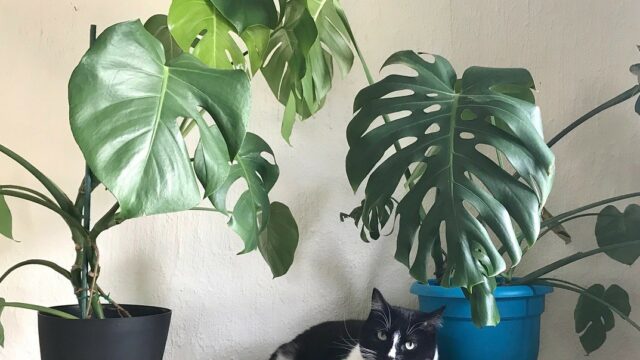
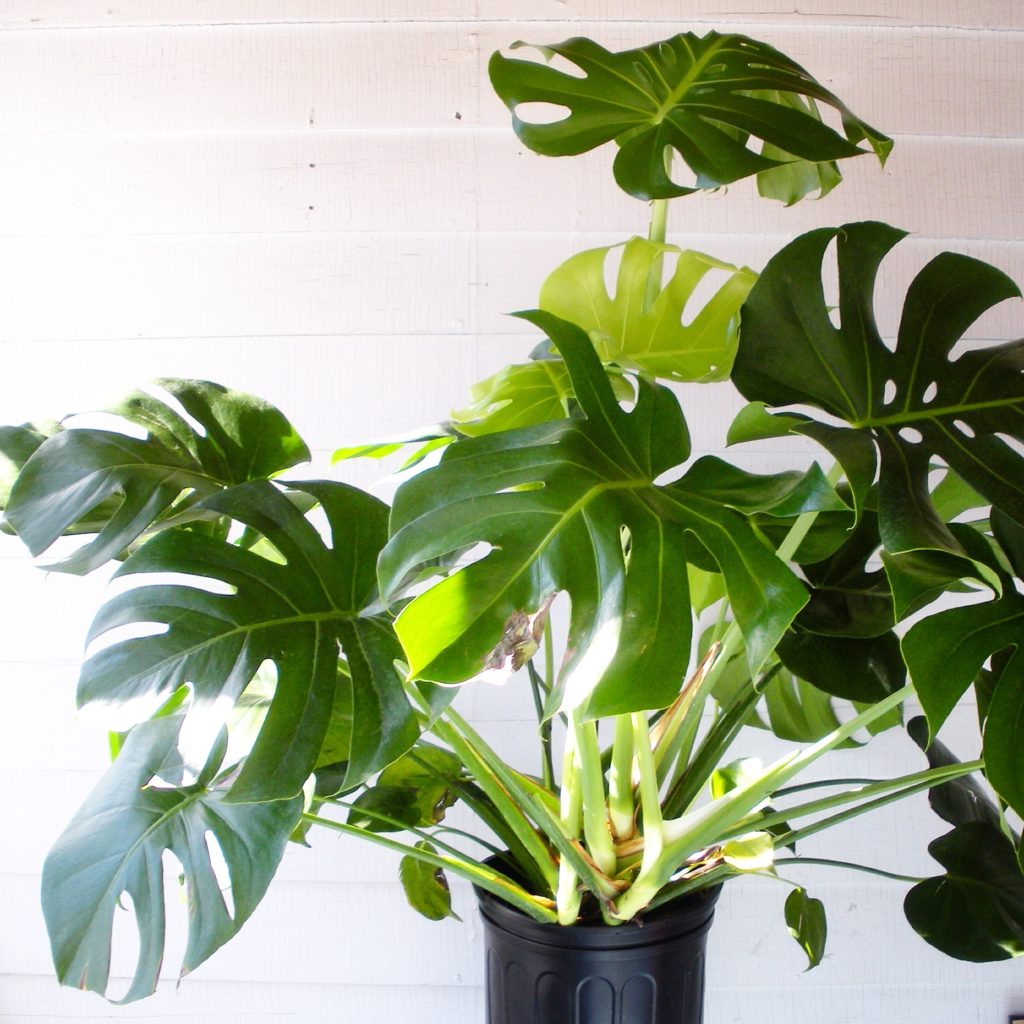
One of the best parts of the IG plant community? #Monsteramonday, featuring the lush and exotic Monstera deliciosa.
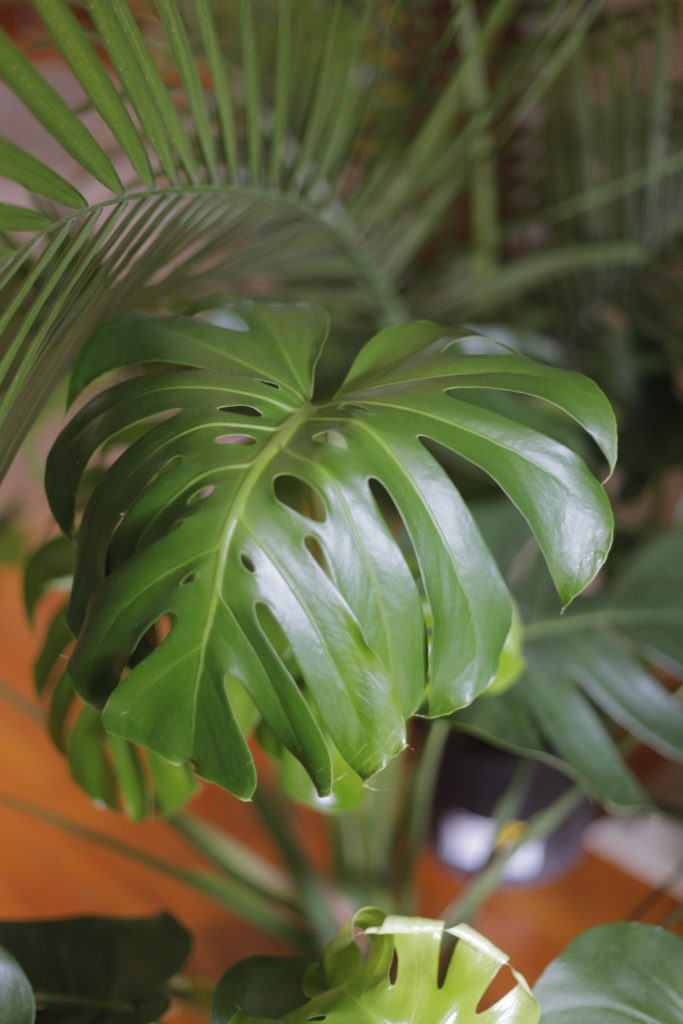
Out of all the social media platforms, Instagram is the best for plant lovers. Once Leaf & Paw was born I was excited to create its own account.
First off, every Monday is #monsteramonday. IGers present luxurious photos of these giant Jurassic Park plants that I had never seen before (in 2017 anyway…). Maybe it’s just NY, but Monstera deliciosa, also called the Swiss Cheese Plant, was not a common one. After seeing photo upon photo of green deliciousness (get it? like “deliciosa”), I had to have one of these. Since they were scarce in NY, I was shocked, SHOCKED that weeks later I saw one, ONE in Wegmans for $15. Now that I have one of these monsters (get it? like “monstera”) it has ultimately become my favorite plant child. His name is Monty.
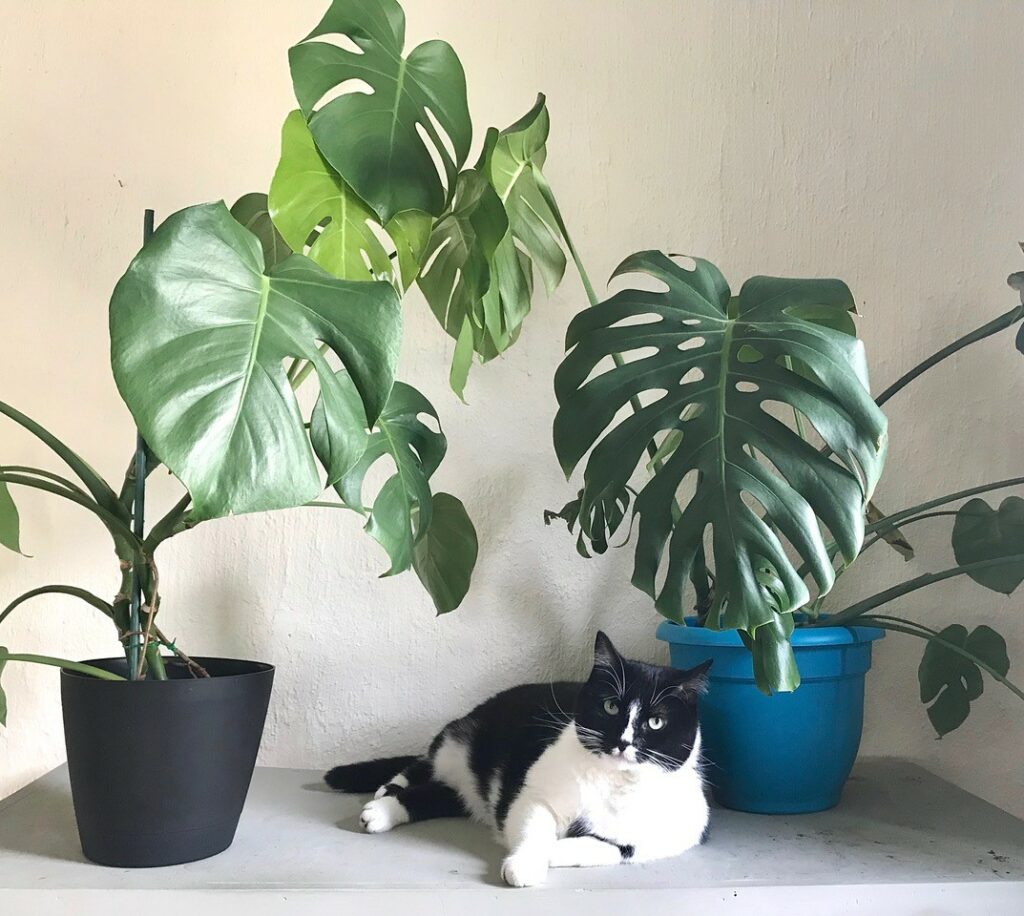
Once I/Leaf & Paw/Monty became active in #monsteramondays, I was surprised to receive a message asking why I own a toxic houseplant in a house of cats, despite my blog being all about safe plants for pets. Makes sense, so I’ll clear the air.
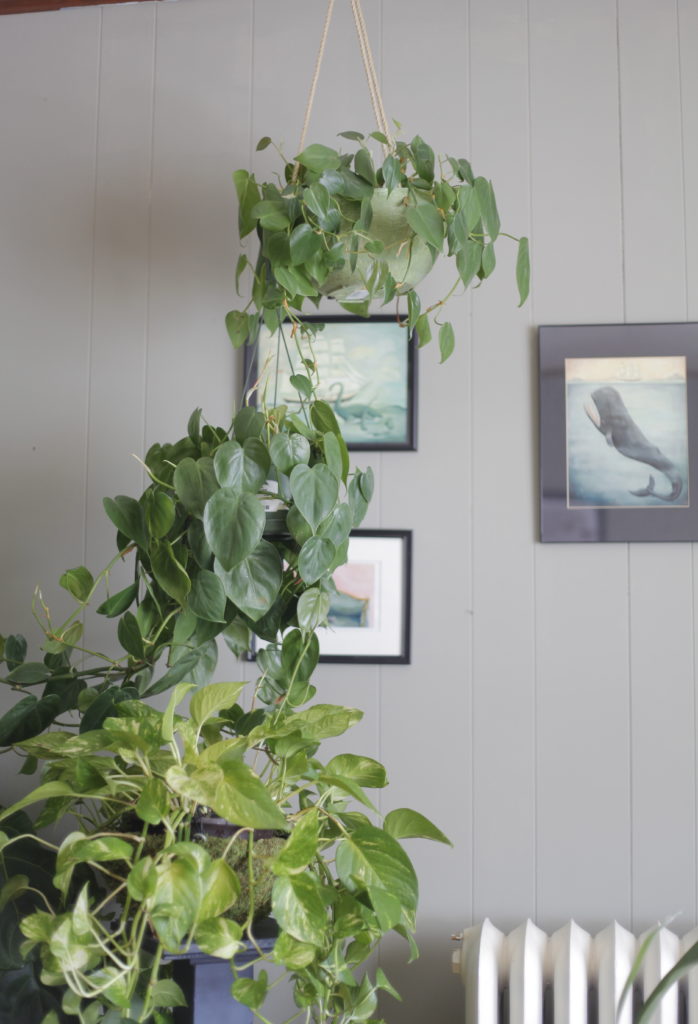
Are Monsteras Safe for Pets?
Monstera is a genus – a vast plant group that includes other types of Monsteras too. They’re very similar to the Philodendron genus which includes the heart shaped philodendron (above) and the elephant ear plant (below), BUT Monsteras are not related to Philodendrons. Confusion continues to arise since a common name for Monstera deliciosa is “Split Leaf Philodendron” which is, well, botanically incorrect as these are two different plants.
Part of the Araceae family, Monsteras are considered toxic, but less than its siblings, the Calla Lily and Dieffenbachia. These two plants are more poisonous in general on the toxic scale, so I recommend avoiding them. Monsteras are only toxic in excess, causing stinging around the mouth and stomach upset if consumed consistently.
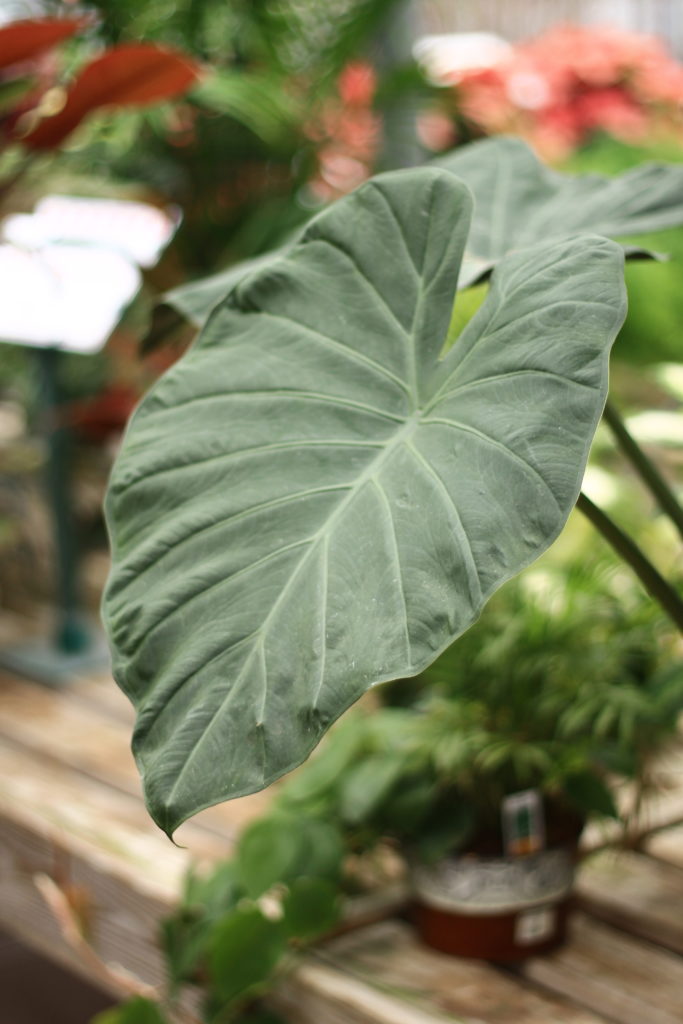
In my Ficus elastica post, I came across this similar situation – I have quite a few plants that are toxic to animals and I’ll explain why I do. The main reason is leaf size. My cats, and it seems cats in general, fancy stringy, grass-like leaves that are easily chewable – like palms and spider plants. I have never had a problem with cats or dogs chewing, or even showing interest in large leaf plants, since they seem more like furniture than a salad. Monstera deliciosa are no exception with its plasticky leaves’ average size being 10″ in diameter. Honestly, leaf size is the key. So, to those wondering if it is ok to get one of these beauties, I say yes, as long as your pets aren’t destructive-consuming-plant-vacuums. In the end, you are the only one who knows your pet.
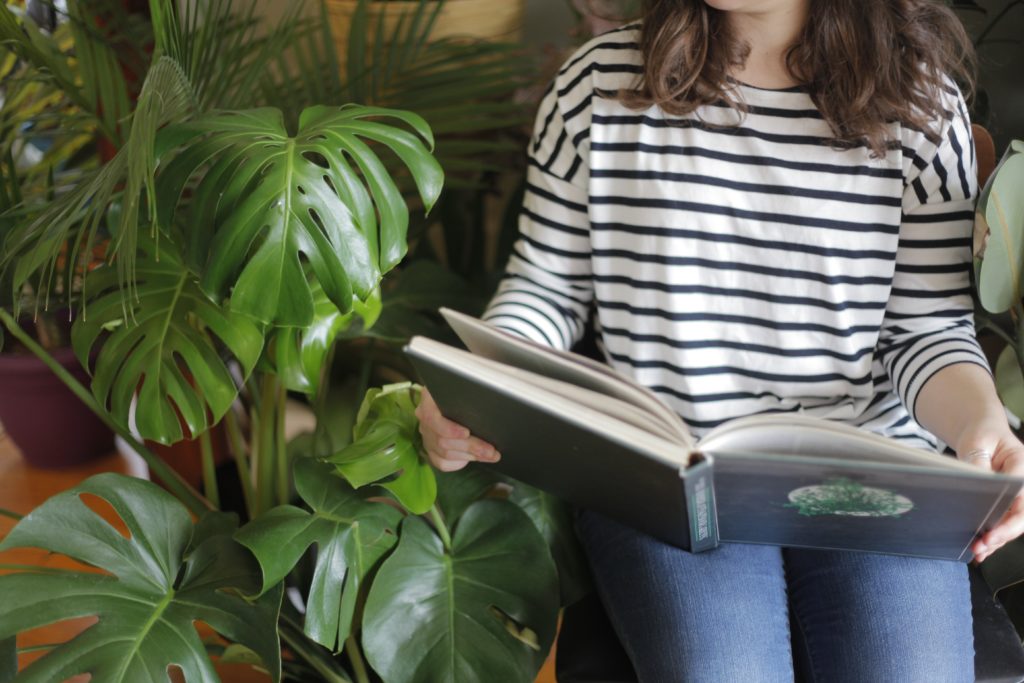
Basic Care
Monsteras are easy to take care of. Plant them in well draining, high quality soil, with plenty of perlite and rocks. The soil mix should stay relatively moist in all seasons, and you should only water when the top 1/2 of the soil is dry. I water Monty once a week and he lives in a east window with indirect light all day long.
Speaking of light – Monsteras aren’t too picky, but, like all plants, they will do their best in filtered light and ample humidity. Monty was in his plastic pot for a good six months and was just peachy. The photo below is when I first got him (plastic brontosaurus for scale), and the first picture in this post is his size eight months later. Sniff, I’m so proud.
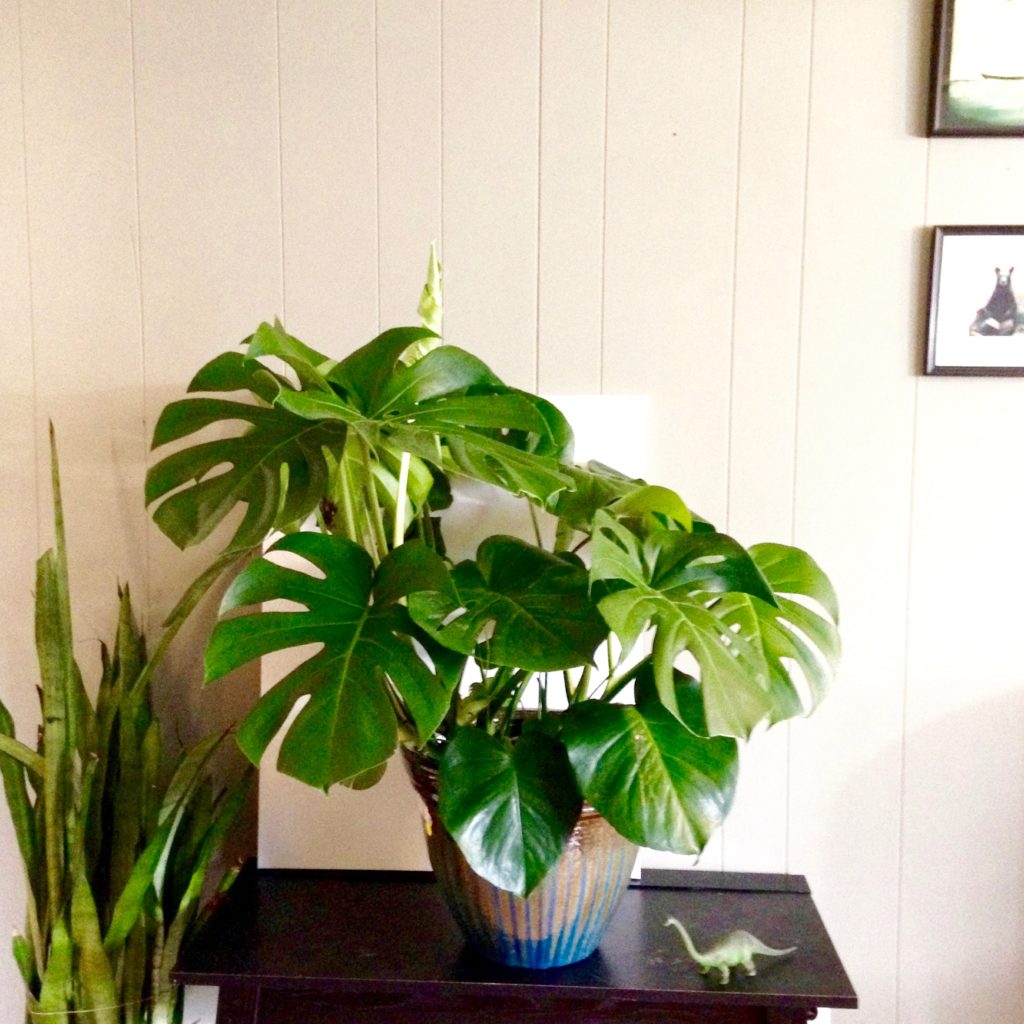
Monstera Problems
I consider Monstera deliciosa to be a pretty hardy plant, and oddly tolerant of being shoved in a home instead of a jungle. Sometimes, though, Monsteras can be affected by bugs and less-than-ideal conditions, so here are some common things to look for:
Yellow leaves: Monstera leaves turn yellow as they age, which is normal. What is not normal is a young Monstera with lots of yellow leaves, that means there’s a problem with watering. Overwatering or chronic sopping wet soil will result in leaves that yellow then turn brown. This is an indication to revisit your watering schedule or plant placement and invest in a moisture meter.
Metallic looking leaves: Spider mites can attack Monsteras, leaving the leaves with a slight metallic sheen and pitted appearance. You may also find tiny red bugs moving around and some webbing between stems. Spider mites are really gross and can spread to your other plants if not addressed. I recommend hosing the plant down completely and treating with an insecticide asap.
Fungus gnats: Soggy soil can create root rot or cause fungus gnats, which are small annoying bugs like fruit flies. These sticky traps work great, but you’ll want to replant your Monstera in fresh soil. While you’re doing that, inspect for mushy or black roots (which you should remove if you find any), which can indicate root rot.
Brown edges on leaves: Don’t be alarmed, brown tips on Monstera leaves is actually ok. While it means your plant could use more humidity, it also happens inevitably as a Monstera ages. At the end of the day, a humidifier running a few days a week can’t hurt.
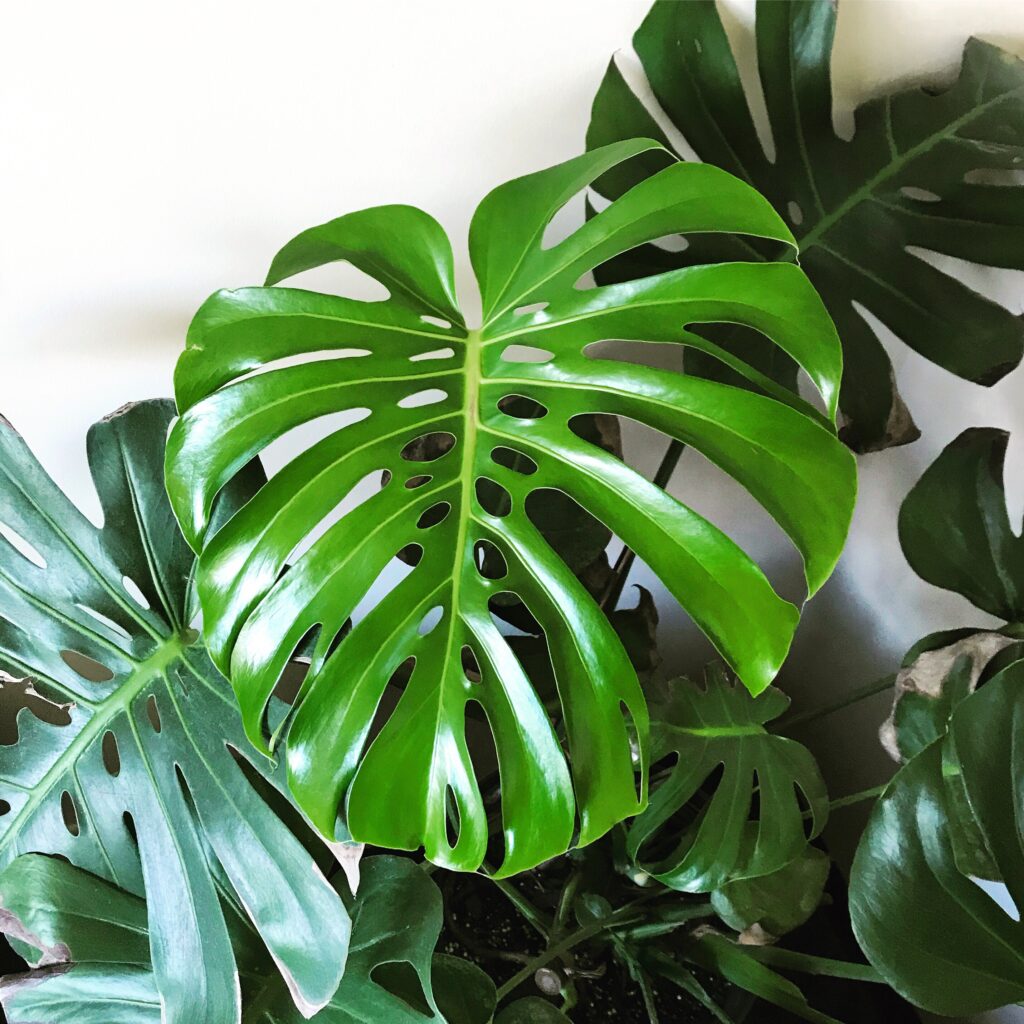
Propagating Your Monstera
Luckily Monsteras are also much more available now (a couple years later) – especially on the internet from plant shops like this, but you can also propagate larger plants to make more.
Well, a year later (now February 2018), I’ve propagated Monty! Below is the new cutting. This was a very fun and rewarding experience that I talk all about in this post. I include a step-by-step guide and lots of pretty pictures so you can grow your Monstera collection, too.
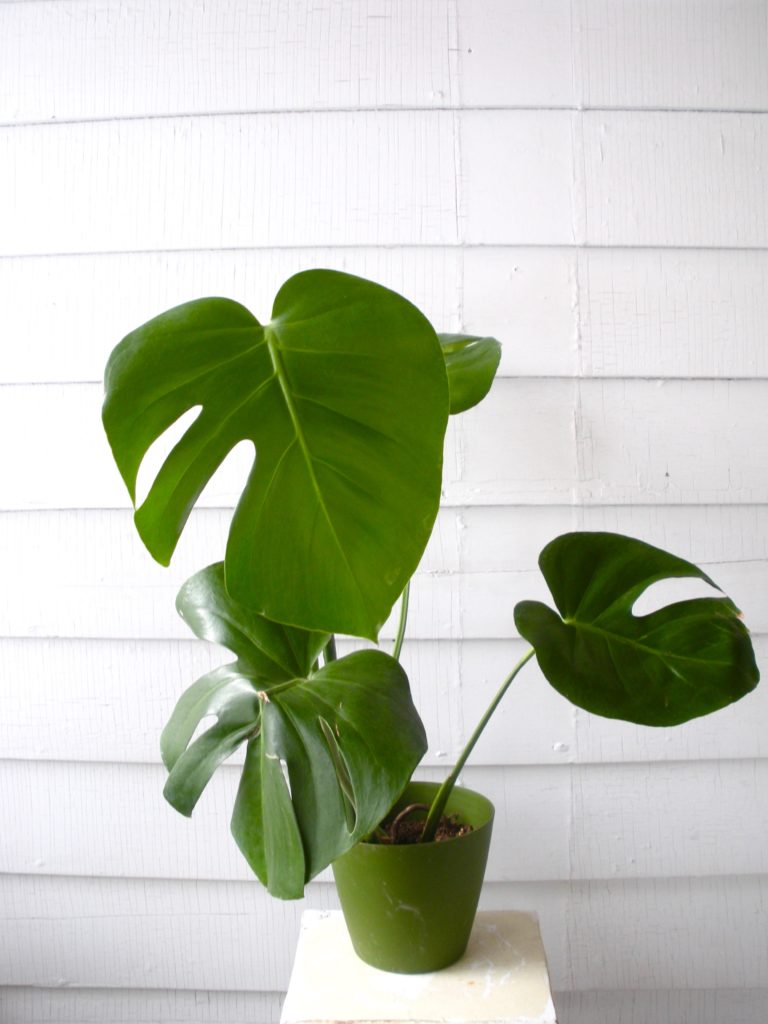
*This post contains affiliate links and Leaf & Paw does receive a percentage to fund our content. 🙂

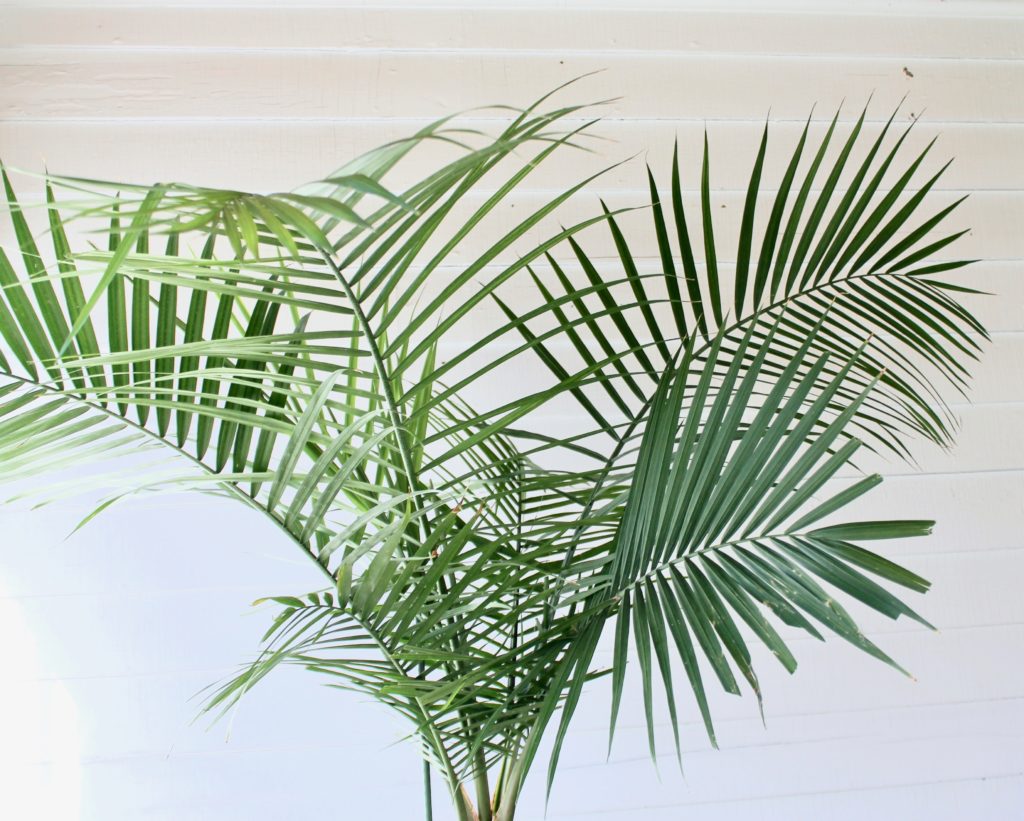
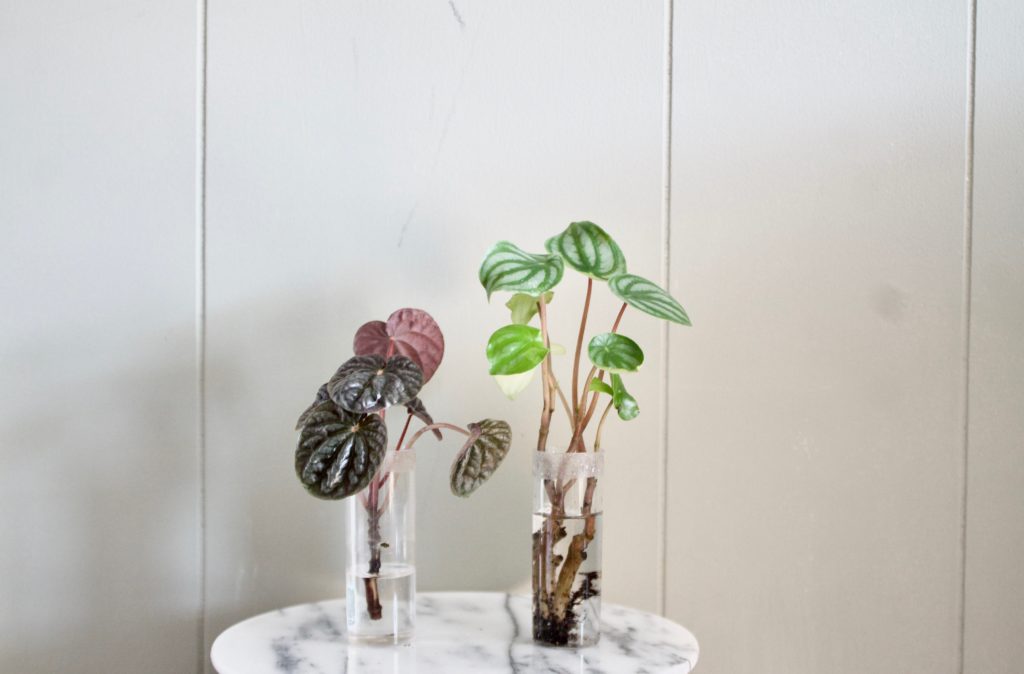
Funny thing about monsteras and many other plants of their ilk — they’re considered “toxic” because of insoluble calcium oxalate crystals. These crystals are not poisonous, which is what I think most people picture when they hear the word “toxic,” though they *are* extremely irritating (the crystals are tiny and very poky). An animal that tries to ingest one is not likely to eat much of it, and probably won’t make the same mistake twice! Like you said, it’s mostly a thing of excess.
I can’t fault people for exercising an abundance of caution, though. It’s hard to see a pet in distress.
Exactly, Jecca. I luckily do not need to worry about my cats eating monsteras, or really any of my dubbed “poisonous” plants. They keep their distance. Yes, caution is good, which is why I felt it was somewhat necessary to do a post about just that. 🙂
Thanks for that clarification ,I’m the new owner of this plant and am confident my pugs would prefer treats than this plant ?
Thank you for the info. I’ve always wanted a monstera but my cat is a nibbler and I’ve always been worried about this plant. And when you said your cats are more inclined to do the “grasses” … I realized my girl is the same. So I shall get on the hunt for a monstera and once I find one, I’ll keep a close eye on her to see how everything goes. ??
You’re welcome Barb. Hope you find your own Monty soon! 🙂
I love this post! I too have some toxic plants, but my cats don’t really show much interest. I have been keeping my monstera up high, but eventually it will get heavy and need to be on the ground. Your posts are lovely!
Thanks for reading Samantha!
Yes my experience confirms what you say. I tried chewing some of my mature tough Monstera deliciosa leaves to see if they have that “pins and needles” effect in the mouth like I’ve experienced with raw taro and other relatives ( I carefully spat it out and rinsed my mouth after a few minutes)… little or no detectable effect on inside of mouth ( it’s possible young tender leaves are higher in toxins to deter browsing but I didn’t have any available to test).
I was thinking of planting this as part of a hedgerow against goats since they are not stupid and don’t eat the related Arum Lily (Zantedeschia aethiopica) which is wild around here. On the basis of this trial I doubt this would be very goat proof despite many reports on the net & in books they contain calcium oxalate crystals.
I hadn’t heard before about the leaves being a problem, but people whose other reporting has been reliable say the unripe fruit DEFINITELY contains significant quantities of the crystals.
Thank you for this reassurance! I had 2 as a child Charlie and George lol they where massive my cat used to sleep in the pots never got sick both lived together for 15 years. Iv just recently got a cheese plant he is called Claude we are getting kittens next month had been told to ditch Claude as he is toxic!! Not going to happen I will just watch for chewing thank you ? ???
Claude is the best name! Yes, just monitor your cats and watch for chewing – kittens are notorious for getting into and eating everything. It may help to put Claude on a tall plant stand until your kitties get a bit older too. I’ve found that helps with kittens.
Great post!! I have a cat and numerous plants, some being toxic. the only plant she has ever showed interest in is my parlour palm. She sniffs my calatheas from time to time but no nibbling as she is mostly just attracted to things that resemble grass. This put my mind at ease. My monsteras are off-ground for now but one is getting quite heavy so I was contemplating putting it on the floor. I was concerned that if she did nibble it (which would be so out of character as she has never gone for any plant other than a palm) that it would be an immediate, intense poisoning effect so I am glad to have learned that it needs to be consistent! I am so lucky she is just not that interested in anything other than the palm, which I moved because I didnt want to it to look destroyed. Thanks for sharing
Glad I can help Shannon!
Hi!
Do you know if the water dripping from the leaves (guttation..(?)) is poisonous to cats? My monstera is dripping every morning and is messing upp my floor a bit, but I’m more concerned for my cats and if they lick the water.. I have googled but not found anything about it. Is it just plain water or does the plant release something toxic in it? Hope you can help!
Hi Ebba, I would think it’s not toxic, as it’s just a form of condensation but I’m not 100% sure. Depending on the size of your monstera, I would put a tray or those plastic things that go under pots to collect the water, and place it on a plant stand. That should help the cat and water destroying floor situation. I hope that helps!
Thank you for this post
I have been wanting to plant a tropical style garden in my yard but have been hesitant due to my dogs we have many other plants in our yard that were already established and they havent been bothered by but whenever i have looked up a plant i would like to add and it just comes up as toxic to pets i have completely avoided it.
Other than grazing a little on the grass or eating mandarins that have dropped from a tree they have only found interest in our palm tree after an old branch has dropped they find it entertaining to run around the yard with it chasing each other but they dont actually nibble on any of the leaves or bushes in the yard so this article puts my mind at ease. Thank you
Hi Jessica – Yes, unless there is some serious munching or consistent nibbling going on you should be fine!
Hi!
Great article – makes me feel better about accidentally buying a monstera for a friend who owns a cat!
Question – Their cat doesn’t bother with plants at all (lucky!). However, in having this plant in my bathroom for a couple days while I wait to see my friend (my cat will certainly try eating it), I’ve noticed it dripping water. I read that this is normal, but is that water toxic to cats? I’m positive any cat that sees a drop of water will try to lick it.
Thank you!
Hi Dania! The water droplets are transpiration which is totally normal and kind of like people sweating. It shouldn’t happen too much in Monsteras and is usually a sign of overwatering since it needs to release that excess moisture. I wouldn’t say this water is totally safe, especially from a philodendron/monstera, so I would relocate said plant until you no longer see droplets. I hope that helps!
Thank you for this article, I’ve always wanted two thing in my new home – a monstera and a dog, so I was heartbroken when I read that these two should not be kept together. As the breed I’ve chosen is very likely to munch on things they’re not supposed to, I’ll definitely try to keep the plant out of reach, but it’s good to know it’s not nearly as deadly as some other plants.
I got my monstera about a week ago. He is called Corazon. The problem is that my cat keeps nibbling. I don’t suspect shes really EATING him, but there are new teeth marks every day. I’m really curious if shes just super cat and immune to the toxicity or pain or whatever or if shes just REALLY DUMB. She isnt showing any signs of pain, no drooling, no lethargy (other than normal “holy heck it is July and the ac is broken please just let me stretch out by the fan”) and no change in appetite. I realize you’re not a doctor to offer advice but like … how concerned do I need to be? I really don’t have anywhere else in my apartment right now that gets as much light as the bedroom and I’d feel like a monster if I locked my cat out of the bedroom for 11 hours while I’m at work. And I really love Corazon and dont want to get rid of him OR him to murder Discordia whom I also love, and have loved for much longer.
Hi! I would try a tall plant stand, this way you can keep Corazon off the ground, near the window, plus a plant stand usually doesn’t allow room for cats to hang out on them. Discordia is probably not a super cat; if she’s not swallowing the leaves or parts of the leaves she’s probably fine, but too much nibbling or if she starts to actually consume the plant it could be dangerous. I would try the plant stand, or some kind of way to get Corazon off the ground, and also supplying Discordia with cat grass. She may not be very smart (mine aren’t either) but she may also be missing some greens in her diet and the cat grass might help. I hope this is helpful!
Are these plants also air purifiers?
All plants purify the air somewhat, but monsteras are not the best plants for the job. This post Air Purifying Pet Safe Plants about air purifying plants should help!
Love it! I just bought my first Monstera and was worried about my pets! Thank you for all the infos!
Thank you for this, I just bought 2 different Monsteras 2 hours ago, and then I read it is toxic but thanks for clarifying ?
You’re welcome!
hey I love your posts!I bought a Monstera a couple of weeks ago and named it eustace. I am 11 so I can’t put my plants all over the house.I have been noticing that his leaves curl up every day and I read that this means that you should water them more,but if that is so then I will have to water him every day and I am scared that that will lead to over watering wich will kill him but if I don’t water him then he will dry out! HELP!
Hi Kyla! First off, plants are better to be too dry than too wet. Curled leaves can mean a few things – it can mean the temperature is too hot for them, they may have bugs, or the soil is very dry. You can check the leaves for little black or white bugs to start. Next make sure that when you’re watering you are watering very well, so that any excess water comes out of the drainage hole in the planter. Typically Monsteras can be watered 1-x a week but shouldn’t need more than that. Let me know if you have any more questions!
ps: do you know any thing about string of fishhooks plants,if so how do I make mine grow faster?
Hey again! They are similar in care to String of Pearls. Basically they need lots of bright sun and need to dry out between waterings. Without bright sun, they tend to do poorly and can rot. Also be sure they are planted in sandy soil.
I love my monstera, but I will say that I had a cat for a little over 6 months that took a nibble of it and was SO SICK. We couldn’t figure it out until the third vet visit when I remembered I heard her take a nibble out of it one morning. She couldn’t eat for at least a week before we were able to get her the right medicine. She certainly wasn’t EATING the plant as there were only a few tooth holes in it. I want to caution anyone to please take caution and put your monstera up high or somewhere your kitties can’t get to it. It can only take a nibble to make them sick. 🙁
I agree Nicole! I’m glad she’s ok!
Thank you for this post! I have been so worried since I discovered my monstera was considered toxic to cats, and was going to get rid of it, even though my kitty has never shown an interest at all in it. This makes me feel so much better about keeping it. Most websites just say “toxic” and leave you to assume this means your cat will die if she eats it — so unhelpful!
You’re welcome! Although, I would still keep an eye on her so she doesn’t eat them, it probably doesn’t feel good for her if she does.
So happy to have found this post 2nd in line for my google search!! I just got home and my dog ate one leaf, I was starting to stress after the first page I looked up, but your article articulated what actually is “toxic” in excess, my little husky will be just fine. 🙂
And you suckered me in for the propagation post ahah
Thank you for this post! I was worried as I just got a monstera that it was highly toxic to my cats and dogs. But if my monstera was in a room that my cats and dogs didn’t have access to at all, it would be okay? It wouldn’t have any affect on my cats or dog if they didn’t have any contact with it at all?
Hi Oliver! That should be a fine placement, just make sure to monitor and to make sure any toxic plants, like the monstera are out of reach. If there is no contact or consumption, there is nothing to worry about.
Oh my gosh! Thank you for this post (it is a well repeated phrase I see). 😉
Leaf size, yes! My spider plants are cat magnets.
Just discovered my 5ish Maine coon rescue has been happily munching on my monstera for at least a week. I just found out it was toxic but my kitty seems fine. Obviously removed plant. Should l be concerned.
Hi Laurel, I would call your vet asap and see what they recommend. Every animal is different and it’s better safe than sorry!
I have an oddly specific question – do you know if the toxic chemical is in the leaves only or also the aerial roots? My dog likes to nibble on the roots (my theory is that they get in the way of her sunny napping spot). Anyway, no symptoms so far but curious about how seriously I should try to stop this.
Hi Michelle, if a houseplant is considered toxic, as Monsteras are, it is typically more than one part of the plant that is. I know the leaves are definitely toxic, but considering these are high on the toxicity list I would definitely try to stop this behavior asap. I would try putting the plant on a plant stand so it’s not at chewing level, or move the plant completely.